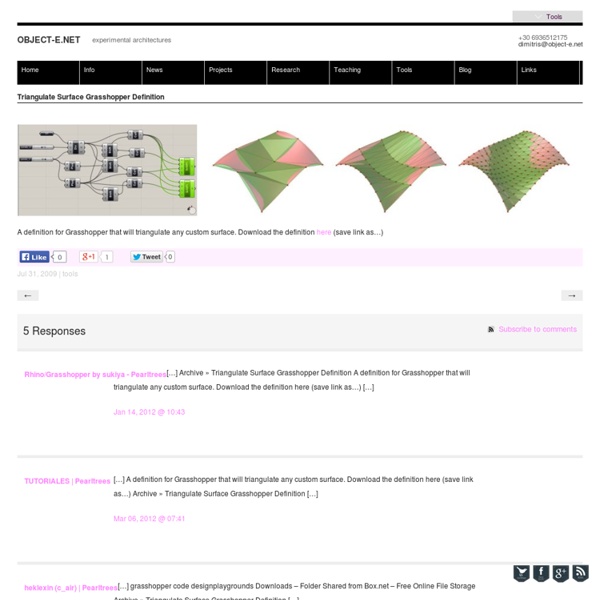



IsoCurveSurface 04 ///////////////////////////////////////////// Dec07// Master degree at Politecnico di Torino with a computational design thesis TMD_tsunami memorial design competition, network as design tool::: prof.Roberto Apostolo, prof.Mario Grosso, Arch.Andrea GrazianoJan08// Join at studioGriffa, Turin as project architectFeb08// at DRL TEN exhibition, Architectural Association, London with K_pavilion project ::: visiting Zaha Hadid Architects London, attends co|de lecture: Shajay Booshan, Danilo Arsic Feb08// K_pavilion publicated at DRL TEN book.Mar08// UIA infopoint competition.May08// MCA, Mario Cucinella architects "Una stanza di luce" workshop at Cavallerizza Chiablese, TurinJun08// Workshop “Parametric Architecture” tutors Ludovica Tramontin Asp(e)x and Erich Schoenenberger(Su11 architecture+design, Pratt Insitute, NY, USA)Jul08/// Torino World Design Summer School “Prototyping the city” assistant tutor of EcologicStudio-Architectural Association, NSU-GSAPP-Columbia University and Politecnico di Torino+ Configuration 0 project.
Example files edit 29/04/14 - Here is a new collection of more than 80 example files, organized by category: This zip is the most up to date collection of examples at the moment, and collects together a wide variety of definitions made for various workshops and in response to forum questions. Thanks to all workshop attendees and forum members for your valuable input. It is possible I've missed a few useful ones. The examples below are mostly older, but I will leave them here for now until I am certain all the same topics are adequately covered in the 'official' collection above. Showing how the trail component can be used to trace the motion of moving particles The wind component acts on sets of 3 points (typically each the vertices of each face of a triangulated mesh). CurvePull - Pulls particles onto a curve. The Vortex component rotates one particle about an axis defined by 2 points. Align Pulls two line segments towards being parallel. (also requires WeaverBird) shell_and_plate_example_updated.gh
How to change Planar Surface Trims And Best Fit Rectangles I don't know if I can, but I want to get more control over the rectangular bounds used for planar surfaces. In the photos below, you can see how some planar surfaces, when untrimmed are aligned to the world coordinate system, while others are aligned to to the edges of the regions used to make them. Is there a way that I can define the plane for each one? Tags: Attachments: ▶ Reply to This
GH: DISTANCE GROUPING This definition groups objects into lists based on their distances from a point(s) 1. Set points as collectors (they will make the groups)2. Set points to be grouped3. Evaluate the cross referenced distances to find the minimum distances 4. GH Version Tip One of my personal favorite definitions, it is very versatile.Try it for attraction, structures, coloring, voronoi patterns and so much more.
How to get the outline of overlapped shapes? Hello all, I'm a beginner in Grasshopper so if I'm not make sense so please bear with me. I've generated some snowflakes in 2D with a messy grasshopper script (is this how it's called?) and I'm having a hard time to get the outline profile of each of them. I tried using Region Union and some of the bits came up missing randomly. I tried baking it and then use the Rhino command MeshOutline onto each of them individually and it works sometimes, but it's still missing some random pieces sometimes. Is there a way to elegantly and perfectly trace out the outline profiles of each of the snowflakes? I've attached the GH file and a screenshot to explain my problem. Thanks, Ching Tags: outline, profile Attachments: ghhelp06jan2012.png, 297 KB ▶ Reply to This
o---FANCYWIRES--{>} Surface Creation - Workflow? I've hit a frustrating wall. I have three curves, all in different planes. Normally, in Rhino, I'd just pull a quick 'Surface > Edge Curves' to create a surface from these... and it's functionality that I'm not finding within Grasshopper. Of course I can easily 'Bake' the three lines into Rhino and work from there, but I'd really rather not loose the parametric/editable nature of the geometry. -Three object/component curves "var_Crv" are to the far right of the Canvas. It's probably something very simple. Tags: create, creation, curves, edge, srf, surface Attachments: 090516_Learning.ghx, 282 KB ▶ Reply to This
AADRL 2013 – Algorithmic and Production Skills with Rhino + Grasshopper – Session 8: Genetic Algorithms » VITRUALITY In this session we will be looking at some more advanced components and methods of using grasshopper, principally focussing on Galapagos, Grasshopper’s built-in genetic algrithm solver. Along the way, we’ll also be examining Grasshopper’s metaball component and means of flow control – the Grasshopper equivalent of ‘if statements’ in coding. Example 7: Galapagos Galapagos is best used to solve problems to which the optimal solution is not immediately obvious. In this example the problem which we are going to try and solve is to examine a field of points and attempt to enclose as many of those points as possible within a closed curve of a fixed maximum length. If you want a physical analog – imagine that each point is a pin and we have a loop of string that we want to fit around as many as we can. The first step is to obtain our set of points – you can either use the one in the example file provided or create your own using the Points command and clicking lots. Metaballs Galapagos Max. 1.